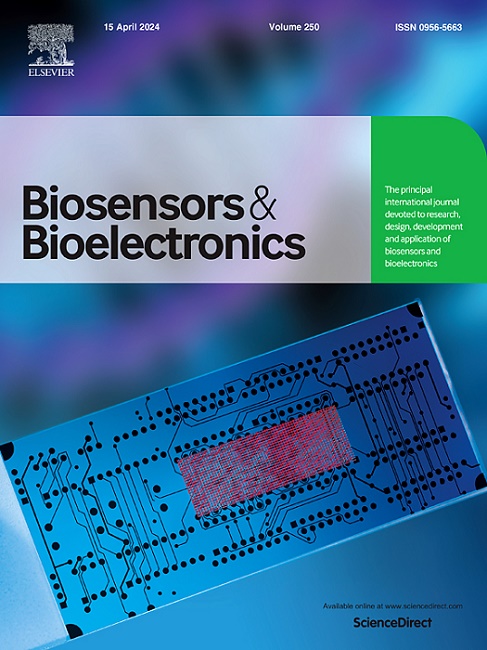Novel Siglec-1/β-CD/rGO impedimetric biosensor for detecting Neu5Ac expression in red blood cells
IF 10.5
1区 生物学
Q1 BIOPHYSICS
引用次数: 0
Abstract
This study introduces a beta-cyclodextrin/reduced graphene oxide/indium tin oxide (β-CD/rGO/ITO) microelectrode platform for the real-time, non-invasive, and label-free detection of N-acetylneuraminic acid (Neu5Ac) on red blood cell (RBC) surfaces. By leveraging advances in CRISPR-Cas9 technology, genetically modified pig-derived RBCs with reduced immunogenicity have been developed for xenotransfusion applications. However, elevated Neu5Ac expression in some modified RBCs complicates immunological assessment. The developed platform demonstrated exceptional sensitivity, specificity, and reusability, enabling selective monitoring of Neu5Ac levels on RBC surfaces through interactions with Siglec-1, a macrophage receptor for Neu5Ac. Results effectively distinguished genetically modified pig RBCs (double knockout (DKO), triple knockout (TKO), and quadruple knockout (QKO)) from human RBCs (HuRBCs) based on Neu5Ac expression. DKO RBCs exhibited the highest impedance value (50.43 ± 3.28 Ω), while HuRBCs showed the lowest (6.29 ± 3.14 Ω). The platform's 98.6% reusability after sialidase treatment and its ability to screen substances that inhibit Neu5Ac-mediated immune recognition highlight its potential for therapeutic applications. These features establish the β-CD/rGO/ITO microelectrode as a valuable tool for quality assessment of xenogeneic RBCs and for advancing clinical and translational applications in xenotransfusion medicine.
用于检测红细胞中Neu5Ac表达的新型siglec1 /β-CD/rGO阻抗生物传感器
本研究介绍了一种β-环糊精/还原氧化石墨烯/氧化铟锡(β-CD/rGO/ITO)微电极平台,用于实时、无创、无标记地检测红细胞(RBC)表面的n-乙酰神经氨酸(Neu5Ac)。利用CRISPR-Cas9技术的进步,已经开发出免疫原性降低的转基因猪源性红细胞,用于异种输血应用。然而,Neu5Ac在一些修饰红细胞中的表达升高使免疫学评估复杂化。开发的平台表现出卓越的敏感性、特异性和可重用性,通过与巨噬细胞受体siglec1的相互作用,可以选择性地监测红细胞表面Neu5Ac的水平。结果基于Neu5Ac的表达可有效区分猪红细胞(双敲除(DKO)、三敲除(TKO)和四敲除(QKO))与人红细胞(hurbc)。DKO红细胞阻抗值最高(50.43±3.28 Ω), hurbc最低(6.29±3.14 Ω)。该平台在唾液酸酶处理后的98.6%可重复使用,以及其筛选抑制neu5ac介导的免疫识别物质的能力,突出了其治疗应用的潜力。这些特点确立了β-CD/rGO/ITO微电极作为异种红细胞质量评估和推进异种输血医学临床和转化应用的有价值的工具。
本文章由计算机程序翻译,如有差异,请以英文原文为准。
求助全文
约1分钟内获得全文
求助全文
来源期刊

Biosensors and Bioelectronics
工程技术-电化学
CiteScore
20.80
自引率
7.10%
发文量
1006
审稿时长
29 days
期刊介绍:
Biosensors & Bioelectronics, along with its open access companion journal Biosensors & Bioelectronics: X, is the leading international publication in the field of biosensors and bioelectronics. It covers research, design, development, and application of biosensors, which are analytical devices incorporating biological materials with physicochemical transducers. These devices, including sensors, DNA chips, electronic noses, and lab-on-a-chip, produce digital signals proportional to specific analytes. Examples include immunosensors and enzyme-based biosensors, applied in various fields such as medicine, environmental monitoring, and food industry. The journal also focuses on molecular and supramolecular structures for enhancing device performance.
 求助内容:
求助内容: 应助结果提醒方式:
应助结果提醒方式:


